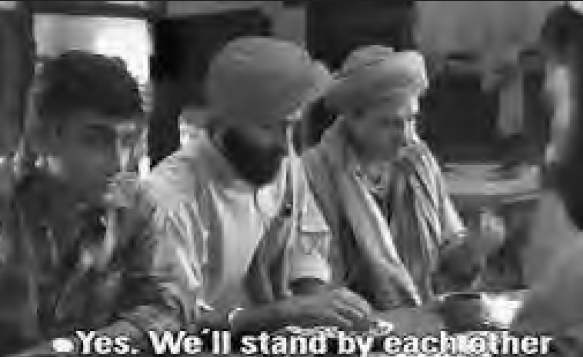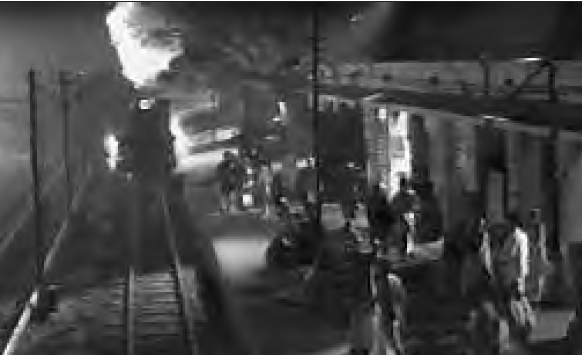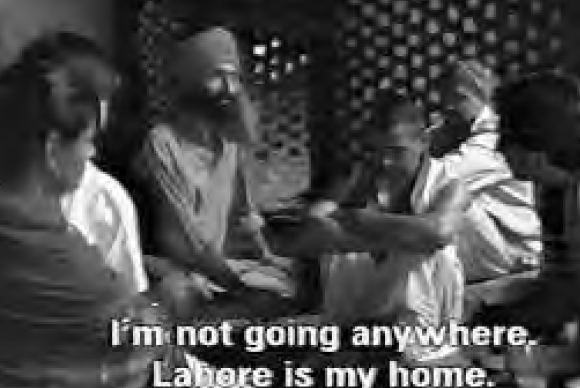
TEL: (212) 274-1989
FAX: (212) 274-1644
WWW.BLOCKBUSTER.COM
Themes identified and approved by educators and key American geography institutions as essential to geographic understanding for students of grades K-12 are those of location, region, place, movement, and human-environment interaction (Geography Education Standards Project, 1994). These fundamental concepts can be appreciated and reinforced while simultaneously exposing students in high school as well as at the undergraduate level in universities to a wealth of regionally specific content matter through the medium of popular film. Carefully selected feature films lend themselves to analysis of regional and topical issues in South Asia and are a good resource for introducing American students to this area of the world. Stereotypical images of South Asia that are widely prevalent in the West such as those of widespread poverty, the caste system, exoticism, and the subjugation of women are often buttressed by the visual media. But the same vehicle can be used to present more nuanced views of the region and promote a better understanding of the socio-cultural, economic and political realities in South Asian countries through discussion of these issues.
In this essay, the five major themes in geography noted above will be explored through a critical viewing of the feature film Earth (108 minutes), written and directed by Deepa Mehta. India has the world’s largest film industry, producing more than 800 movies annually. Many of these films, made in Hindi (the national language of the country), cater to an all-India audience and also are popular in a geographic band that spans the countries of Africa and the Middle East, as well as in other countries in Asia. Generic Hindi feature films are marked by melodrama, spectacular sets, romance, action, and the obligatory elements of song and dance. They are a common form of entertainment and are viewed by people from a wide variety of socio-economic and cultural backgrounds. While many of these ‘potboiler’ films provide insight into the Indian psyche, they often lack regional specificity and may not reflect reality.
Earth, which was India’s official submission to the foreign language film category of the Academy Awards in 1999, departs from films of this genre. A joint Indian-Canadian production, it is based on Bapsi Sidhwa’s novel Cracking India. The film is set in 1947, in the city of Lahore in present-day Pakistan. It revolves around the events that occurred as British India was divided into Hindu-dominated India and the Muslim state of Pakistan. The story that unfolds is told mainly from the viewpoint of Lenny, the disabled daughter of affluent Parsi1 parents. It chronicles the disruption that takes place in the lives of both upper-class people like Lenny’s parents, and the shattering of the worlds of less privileged members of society. This powerful film has scenes of explicit violence and thus would not be suitable for students under sixteen years of age. The teacher may wish to preview the film and skip over scenes that s(he) feels are inappropriate for the high school student.
By examining the tragic effects of Partition through the eyes of a child, the movie attempts to deal with complicated and often controversial material in an objective manner. Although Earth has been criticized by some for being simplistic in its treatment of the complex history of the Partition, the film affords the viewer a glimpse of the social, economic and political conditions that affected Indian society at the time. The role of religion in politics, nation-building and culture, the inter-communal riots and the mass migrations that occurred due to Partition, and their ramifications for society and nation, are all addressed or alluded to in the film.
THE FIVES THEMES OF GEOGRAPHY AND THEIR APPLICATION TO THE SOUTH ASIAN FILM EARTH
LOCATION is considered one of the fundamental concepts in geography. It is the position of a being or thing on the earth’s surface. The location of a place is most often described either through a place name (India, Lahore, Gurdaspur, Amritsar), by describing its site characteristics (topography, vegetation), situation (Lahore is in the province of Punjab in Pakistan, about 30 miles west of the Indian border town of Amritsar) or most precisely, by giving its latitudinal and longitudinal coordinates (Lahore is located at 32° North and 74° 18’ East).

We see in Earth that location is more than geographic positioning. It was critical in determining which populations were most affected by the Partition. The provinces of Punjab and Bengal in undivided India were disproportionately impacted, each being split on the lines of the religion of the majority of its residents. It also is important to note that in addition to location, family circumstance affected the process and outcomes of migration of minority populations across the borders of the newly created countries. The importance of location also is brought home when Lenny asks her mother, “Can one break a country? What happens if the British break India where our house is—how would I get to the park then?”
REGION is another distinctly geographical concept that refers to a spatial entity that displays homogeneity in terms of selected criteria. Students should be introduced to the idea that factors used to delineate a region can be varied. Regions can be demarcated on the basis of physical factors such as climate or landform types, cultural factors such as religion or language, or even a combination of both. The formal region, a subtype, is an area in which a particular feature or characteristic is present throughout. The easiest formal region to identify is an administrative/political unit, because it usually has clearly defined boundaries. Thus, the states of India and Pakistan that were carved out of undivided India are formal regions, albeit those that were delineated using the cultural trait of religion. The vernacular region, or perceptual region is another sub-type, one that people believe exists as part of their cultural identity. Thus, India, although a secular country, is often referred to as ‘Hindustan’ or land of the Hindus.

On a smaller scale, within the city of Lahore, there are ethnic neighborhoods that are populated by Sikhs, Muslims and Hindus. When inter-communal riots with arson and looting break out, watching the fireball that rises into the night sky, Lenny’s nanny’s friend points out that it occurs over a Hindu section of the city.
Students should be reminded that the reverberations of the Partition of India are still being felt. Three wars have been fought since Partition between India and Pakistan, and there is fear that the continued animosity will escalate into nuclear war, as both countries possess nuclear arms.

MOVEMENT refers to how human beings, products, ideas or information move from one place to another. The partition of British India in 1947 was more than a momentous political event. It resulted in the largest recorded human migration in recent history, as approximately 12.5 million uprooted and displaced people moved across the newly created borders of India and Pakistan. This number accounted for about 3 percent of the population of undivided India. In addition, over a million people died as a result of religious and ethnic violence. The viewer gets a sense of the magnitude of the exodus from both countries as streams of people, carrying furniture, livestock and their worldly belongings tied into bundles set out on foot, in bullock carts and by train in search of a safe haven. The move was not without risk. In the film, a scene shows a train from Gurdaspur (now across the border in India) pulling up at the railway station in Lahore and it becomes evident that the passengers, all Muslims emigrating from India, were murdered.


Students should be informed about the “push” and “pull” factors that encourage or impel people to move, and asked to relate these to migration as seen in the film. “Push” factors induce people to leave their place of residence, while “Pull” factors draw migrants to a new location. Usually, migration is the result of a combination of these two sets of factors. Push factors can be political, such as when people are forced to migrate due to reasons such as war, incompatible political ideology and ethnic strife; economic, when poverty and lack of economic opportunity impel people to leave; and environmental, when adverse physical conditions such as natural disasters including floods and drought are the factors determining the decision to migrate. “Pull” factors, too, can be political, economic or environmental in nature. The attraction of a sanctuary, possibilities of economic advancement and favorable surroundings also exert an influence on the decision to move.
The process of migration also is important in the diffusion of cultural traits such as language and customs. These traits originate in a particular locale known as the hearth area, and spread to other places. The kind of diffusion that is very evident in the film is relocation diffusion, which occurs when people migrate and carry elements of their culture with them. The impact of British rule is seen not only in the material landscape, but also in other aspects of life. Lenny’s parents placate their irate British guest by enumerating the various contributions of the British to Indian society, among them the English language and the postal system. Many Indian men such as Mr. Sethna, Lenny’s father, adopted Western attire as formal wear. Elements of cuisine, such as Lenny’s favorite treats like cakes and caramel custard, also were introduced into the diets of Westernized Indians. Because of its time frame, Earth does not address the issue of the new life refugees established in the host countries. A good extension of this introduction to the ramifications of migration would be to study the political and economic dynamics of Mohajir2 politics in Pakistan or the establishment of Sindhis3 as an important business community in India.
PLACE refers to the values, meanings and experiences associated with a location or region. Each place is unique in that it is imbued with certain qualities that make it special. Place has both real and symbolic meaning for its residents. Thus, to the Muslim refugee migrating to Pakistan, or the Hindu leaving for the homeland of India, each country was considered a spiritual home associated with his/her religious identity. Students should be reminded that politicians and governments the world over use nationalism, i.e. loyalty and devotion among a group of people with shared cultural traditions, and often, a shared geographical space, to foster cohesiveness and pride in the nation and create a national image.
Religion, like other cultural characteristics, is a means of identification that can be used to evoke nationalism. Strict adherence to religious edicts is one of the most important ways in which a group maintains a distinctive cultural identity. Not only do people use religion to identify themselves, it is also a potent force in the ways in which they organize the landscape. Religion often leaves a strong imprint on the physical environment. The arches, minarets and domes that we see on existing religious edifices and older ruins clearly reflect the extended Muslim influence in the region. While intense identification with religion can be a source of pride, it can also lead to conflicts with followers of other religions, sometimes leading to the creation of political boundaries, as in the case of India and Pakistan.
However, place can hold meaning to even the outsider. After announcing the imminent division of India and the departure of the British from the subcontinent, Mr. Rogers’s attachment to India even as he reviles it is evident when he says, “This bloody country—it’s the only home I know.” Attachment to place is one of the factors that initially deters Shanta, Lenny’s nanny, from leaving Lahore even though she is urged to do so by her mistress. Similarly, one of Shanta’s friends remarks in the wake of the Hindu-Muslim riots, “It is not so easy to leave one’s home.”

HUMAN-ENVIRONMENT INTERACTION involves the manner in which people adapt to the physical environment and modify it to create cultural landscapes. The city of Lahore, as depicted in the film (although shot in Delhi, India, which has a similar past) varies greatly in its architecture, street morphology and spatial organization. The colonial city with its imposing architecture, wide streets and monuments is juxtaposed against the ‘native’ city with its narrow, winding streets, and crowded buildings. The Sethnas’ bungalow has spacious rooms, surrounding gardens and ornate furniture; evidently an upper-class residence. The houses and tenements of the less privileged present a different appearance, one that reflects more intimately the influence of climate on house type. Students’ attention should be directed to the flat roofs and terraces that are typical of an area with a long dry season and limited rainfall, and the brick walls that keep interiors cool. They should also be advised that cities can be regarded as palimpsests4 that bear the imprint of new and old usage. To the careful observer, most cities provide evidence of different functions over time and the influence of different regimes. Additionally, loose clothing and headgear are examples of how human beings adapt to the hot and sunny climate. Furniture, such as the rope or string beds of the poorer people, also reflects the influence of climate.
The meshing of the five themes of geography in this study of South Asian politics and culture demonstrates that a well-chosen film could be used for an integrated approach to regional studies. Because geography is holistic, such a study could be used to launch further investigation and analyses that are based in other disciplines in the social sciences, the humanities or even the natural sciences.
Study Questions
What are some of the ways in which we can locate the places mentioned in the film? Which of these has greatest geographic precision? In what contexts are these ways of locating most likely to be used?
What is the historical and cultural nature and significance of state boundaries between India and Pakistan and why can they be considered formal or vernacular regions?
What are the relative roles of different kinds of push and pull factors, as seen in Earth, that resulted in the ebb and flow of different population groups across the borders of India and Pakistan during Partition? What evidence do you see of cultural diffusion?
What are some of the tangible and intangible factors that give a place such as Lahore special meaning to its inhabitants?
What factors influence the interaction between human beings and the physical and cultural landscapes? Do you believe that this interaction is affected by social class, religion and gender? Explain.
NOTES
1. Zarathustrianism or Zoroastrianism was the religion of the Persian Empire (present-day Iran) for nearly 1,000 years before being displaced by Islam in the seventh century C.E. While most Zarathustris converted to Islam, a few fled from Persia to India, where their descendents are known as Parsis.
2. The term Mohajir, which means migrant, refers to Urdu-speaking Muslim refugees from India, who fled to Pakistan following Partition. Today, the category includes the original refugees and their progeny. Alleged discrimination against the Mohajirs has led to tension and violence between them and local communities, especially in the province of Sind in southern Pakistan, since the mid-1980s. Mohajir-dominated political groups embrace the ethno-linguisitic label and continue to demand separate ethnic and nationality status in Pakistan.
3. Sindhis are people from the province of Sind in southern Pakistan. Many Hindu Sindhis migrated from Pakistan to India in the wake of Partition. Believed to be astute in trade and commerce, Sindhis form successful business communities in cities all over India, but are especially prominent in the commercial capital of Mumbai.
4. A palimpsest is a manuscript in which old writing has been erased to make room for new.
REFERENCES AND RESOURCE MATERIALS
Al Faruqi, Isma’il R. and David E. Sopher. Historical Atlas of the Religions of the World. New York: Macmillan Press. 1974.
Bose, Sugata and Jalal, Ayesha. “The Partition of India and the Creation of Pakistan.” Modern South Asia: History, Culture, Political Economy. Routledge, pp. 165–89. 1998.
Bose, Sugata and Jalal, Ayesha. “Nineteen Forty-Seven: Memories and Meanings.” Modern South Asia: History, Culture, Political Economy. Routledge, pp. 190–200. 1998.
Geography Education Standards Project. Geography for Life: National Geography Standards. Washington, D.C.: The National Geographic Society. 1994.
Hardwick, Susan Wiley and Donald G. Holtgrieve. Geography for Educators: Standards, Themes, and Concepts. Upper Saddle River, N.J.: Prentice-Hall, 1996. Salter, Christopher L. “Cultural Geography as Discovery,” in Re-Reading Cultural Geography. Kenneth E. Foote, et al., eds. Austin: University of Texas Press, pp. 429–36. 1994.
Sopher, David E. “Geography and Religions.” Progress in Human Geography 5: 510–24. 1981.
The National Council of Geographic Education. Journal of Geography, Special issue on teaching advanced placement human geography. Volume 99, Number 3–4, 2000.
Zubrzycki, John. “Oldest Prophetic Religion Struggles for Survival.” The Christian Science Monitor, May 13, 1998.

